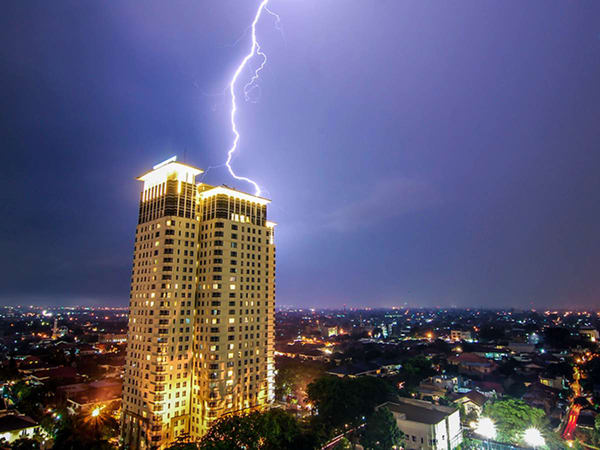
The Basics Of A Lightning Protection: How Does A Lightning Conductor Work
Tuesday 23rd May 2023
the-basics-of-a-lightning-protection-how-does-a-lightning-conductor-work
A Lightning Protection System can protect you and your commercial or private properties from the effects of a lightning strike. You can set up lightning protection systems in your buildings through a Lightning Protection Company, which will also regularly perform Lightning Protection Testing to guarantee everything is in order. But How Does A Lightning Conductor Work? How is the facade of your property going to look when it is installed?
Let's spend some valuable time learning about these systems so that you can make an informed decision regarding your home.
How Does The Lightning Protection System Work?
A lightning protection system is meant to cover a large radius around the property that it is installed on. The various components or parts of a system cover the roof (the most important aspect), go around the home, and ultimately end in the ground. The conductor must be made of highly conductive material, and so should the rest of the parts of the system.
It was originally thought that a lightning protection system attracts the lightning to strike, redirects the electric current, and safely disperses it into the ground. Recent high-speed photography, on the other hand, shows that conversely, lightning conductors and lightning strikes are a two-way system that meets in the middle to dissipate or discharge the lightning. Like how the air becomes highly charged until it causes a bolt of lightning, the ground too becomes highly charged and meets the lightning halfway. This changes how we look at lighting protection and what we know about it.
A Common Question
People often wonder why we don't have many advancements in the field of Lightning Protection despite amazing scientific advancements over the years in various fields. The reason? Lightning bolts or strikes are highly unpredictable, making it challenging to study lightning properly. Lightning strikes being equally unpredictable adds to the challenge of setting up the perfect Lightning Protection System for us.
Lightning Protection Companies do the best they can with the limited knowledge we have today. Until we reach more breakthroughs in our acquaintance with lightning strikes, this is the best we can do today to be safe.
The Various Types Of Lightning Protection Systems
Today, lightning protection systems come in various types. They may be completely concealed - which is becoming more common today, partially concealed, or fully exposed.
Concealed Lightning Protection Systems
More and more homeowners are asking their Lightning Protection Company to install concealed systems today to ensure that the facades of their carefully constructed homes are not destroyed. To have concealed lightning protection:
● You will need to get it done while the house is still under construction. This way, the connections and wiring of the system are hidden and built through the walls and lofts.
● The lightning conductor will still be exposed on the roof. Concealing the lighting conductor sort of defeats the purpose.
● You cannot conceal a lightning protection system on a fully constructed home. You can instead opt for partially concealed lightning protection.
Partially Concealed Lighting Protection Systems
Partially concealed lighting systems are installed on fully built homes when the homeowners want to try can conceal as much of the system as possible. It is not possible to fully conceal a lightning system on an existing home, but with careful planning, most of it can be hidden as long as the loft and other areas of the house are accessible.
It is a great option if you want to get lightning protection systems for your home but are worried about what it's going to do to the facade.
How Does A Lightning Conductor Work?
Lightning conductors and systems are quite simple. When the air is highly charged, a lightning conductor placed at the highest point in a roof becomes an easy target for lightning strikes. This protects other areas of a building and even structures and nature in the surrounding radius, such as trees. The system and all its components are made of highly conductive materials that allow lightning to go through it and protect everything else that may be in its path.
The Finer Details
Contrary to popular belief, the earth also gives off charges that attract lightning. Luckily, the end segment of the system is set into the ground and provides a path for the charged particles to travel up to the conductor placed on the roof. The lightning conductor acts as the meeting point for the charges from the ground as well as the air and thus safely redirects the current and neutralizes it.
Setting Up The Systems On Your Property
You can find a Lightning Protection Company and have them assess your property to find out how they can fit lighting protection for your home. They will first assess your home, especially the roof, and come up with a plan. This strategy will include key areas of your roof and down the wall where the lightning conductor and other parts will be fitted, as well as the appropriate areas in the ground where the earthing conduits should be placed.
Maintenance - What It Means
Maintenance, in this case, is not what you think. All you need to do is request your Lightning Protection Company to conduct Lightning Protection Testing in your home once a year. They will test the conductor, wiring, and other parts to ensure everything is as it should be. If there are any damages or repairs to be done, they'll take care of it and guarantee that your home is safe before the thunderstorms come calling again!
Ideally, you should have Lightning Protection Testing done annually, and it is the standard required in the UK.
Conclusion
Now that you know exactly how everything works, are you ready to protect your family and your home from lightning? South West Lightning Protection is here to promise that your home is ready to face any storm that might come your way.

